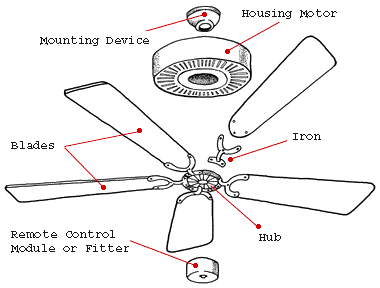Home > House Structure > Ceiling fan
Ceiling fan
A ceiling fan is a mechanical device that is typically installed on the ceiling of a room to provide air circulation and cooling. It is composed of several components, including the motor, blades, housing, and controls. The motor is the core component of a ceiling fan and is responsible for generating the rotational motion that drives the blades. It can be either an AC (alternating current) or DC (direct current) motor. AC motors are more common and typically have multiple speed settings, while DC motors are known for their energy efficiency and smoother operation.

The blades of a ceiling fan are usually made of wood, metal, or composite materials and are attached to the motor via a blade iron or bracket. The number of blades can vary, typically ranging from three to five, and their shape and size can affect the airflow produced by the fan. Different blade designs can create varying air movement patterns, from gentle breezes to more powerful airflow.
The housing or body of the ceiling fan encloses the motor and provides structural support. It is often made of metal or plastic and can come in various shapes and finishes to complement different interior styles. The housing also houses the controls for operating the fan, such as pull chains, wall-mounted switches, or remote controls. These controls allow users to adjust the fan's speed, change the direction of rotation, and sometimes control additional features like integrated lighting.
Ceiling fans are designed to improve air circulation within a room. When the fan is turned on, the rotating blades create a downdraft, moving air downwards and creating a cooling effect through evaporative cooling. This can make occupants feel more comfortable without necessarily lowering the room temperature. In the summer months, using a ceiling fan in conjunction with air conditioning can help distribute cool air more efficiently, reducing the need for the AC to run at higher settings.
In addition to cooling, ceiling fans can also be used in the winter months to enhance heating efficiency. By reversing the direction of the fan's rotation, the blades can create an updraft, pushing warm air trapped near the ceiling down into the room. This helps to distribute heat more evenly and can improve energy efficiency by reducing reliance on heating systems.
Ceiling fans have become popular not only for their functional benefits but also for their aesthetic appeal. They come in a wide range of styles, from traditional and classic designs to more modern and contemporary options. There are also ceiling fans designed for specific environments, such as outdoor or damp-rated fans for use in covered outdoor areas or bathrooms.
Overall, ceiling fans are versatile and practical appliances that offer both functional and decorative benefits. They can provide a cost-effective and energy-efficient way to improve airflow and create a more comfortable environment in homes, offices, and other spaces.
Benefits
Ceiling fans offer several benefits that make them a popular choice for cooling and enhancing comfort in homes and other spaces. Here are some of the key benefits of ceiling fans:
I. Air circulation and cooling: The primary purpose of a ceiling fan is to circulate air in a room, creating a breeze that can help cool the occupants. By moving air around, ceiling fans create a wind-chill effect that makes the room feel cooler. This can be particularly beneficial in warm climates or during the summer months.
II. Energy efficiency: Ceiling fans are generally more energy-efficient than air conditioning systems. They consume less electricity and can help reduce reliance on air conditioning, which can lead to energy savings and lower utility bills.
III. Cost-effective cooling: Installing and operating a ceiling fan is typically more cost-effective than running an air conditioner. Ceiling fans use a fraction of the energy consumed by air conditioners, making them an economical cooling option.
IV. Year-round comfort: Ceiling fans are not just for cooling. Many models are designed to operate in reverse, which can help distribute warm air that collects near the ceiling during the winter months. By running the fan in reverse, the warm air is pushed down, creating a more balanced and comfortable environment.
V. Versatility and convenience: Ceiling fans come with multiple speed settings, allowing users to adjust the airflow according to their preference and comfort level. They can be easily controlled through pull chains, wall-mounted switches, or remote controls, providing convenience and flexibility in operation.
VI. Improved air quality: Ceiling fans can help improve indoor air quality by promoting air circulation and reducing the buildup of stagnant air. This can help alleviate issues related to stuffiness, odors, and humidity.
VII. Decorative element: In addition to their functional benefits, ceiling fans can also serve as decorative elements in a room. They come in various styles, finishes, and designs to complement different interior aesthetics and add visual appeal to the space.
VIII. Quiet operation: Ceiling fans are designed to operate quietly, providing a soothing and comfortable environment without disruptive noise.
IX. Outdoor use: There are ceiling fans specifically designed for outdoor spaces, such as covered patios, decks, and porches. These outdoor fans are built to withstand exposure to the elements and can enhance comfort in outdoor living areas.
X. Environmentally friendly: By reducing the reliance on air conditioning, ceiling fans can contribute to a more sustainable and environmentally friendly living environment. They consume less energy and can help lower carbon emissions associated with cooling systems.
Overall, ceiling fans offer a cost-effective, energy-efficient, and versatile solution for cooling and improving comfort in various settings. They provide a range of benefits that make them a practical and popular choice for both residential and commercial spaces.









